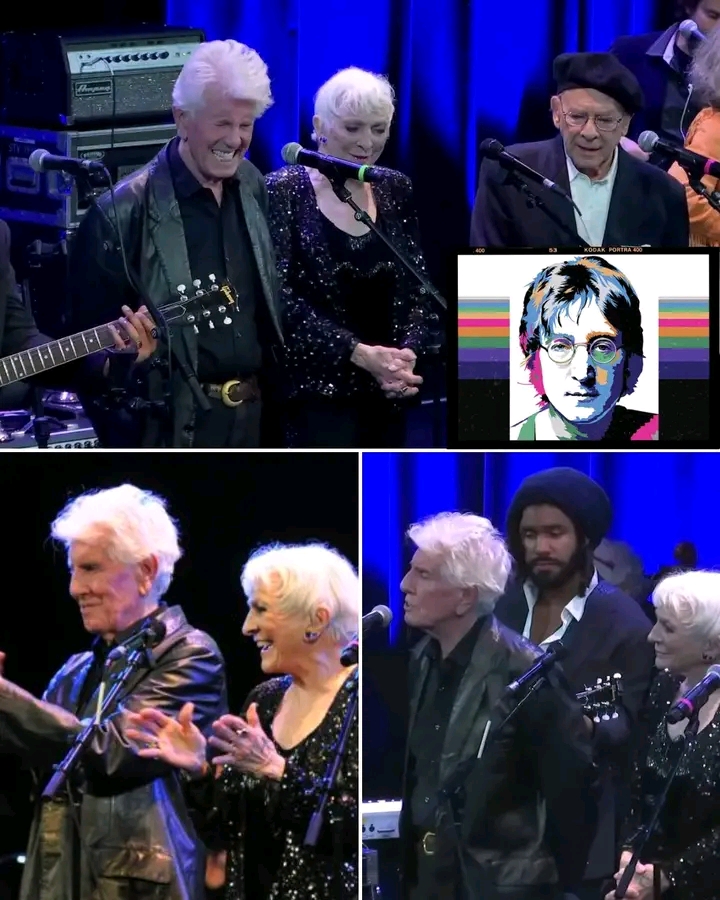
In a quiet moment on a New York stage, three voices echoed a generation’s dreams. Graham Nash, Judy Collins and Art Garfunkel—artists whose harmonies shaped the 60s and 70s—gathered around a single microphone. No backing track. No filters. Just pure harmony. At the 43rd annual John Lennon Tribute, their rendition of Imagine wasn’t just a song — it was a prayer sung by history itself.
A moment of convergence
Backed by little more than memory and respect, the trio stepped onto the stage at Town Hall in Manhattan on December 2, 2023. Nash was being honored with the John Lennon Real Love Award — a nod to decades of activism, songwriting and communal voice. Collins and Garfunkel arrived as collaborators, co-pilots in a voyage of tribute and remembrance.
From the first piano chords, the air changed. Nash opened, Garfunkel followed, Collins lifted the melody — their voices entered one another’s space so seamlessly that the boundaries of individual identity seemed to melt. It was as though the song itself rose, carried by an invisible current of shared history, shared longing.
Why it mattered
Why did this matter? Because we’ve learned, over decades, that music is more than entertainment. The song “Imagine” is more than a chart-topping hit. Written by John Lennon (with major inspiration from Yoko Ono) in 1971, the song has been enshrined as a cultural touchstone of peace, unity and possibility. It’s been covered hundreds of times, used in protests and memorials and moments when the world needed to re-remember what “peace” might sound like.
And here, standing in that spot, were three voices that had helped define what music could do. Nash with his folk-rock roots in Crosby, Stills & Nash, Collins with her ethereal folk presence, Garfunkel with his yearning tenor from the era of Simon & Garfunkel. Each one carried decades of memory, hope and the heavy weight of what their music once meant and what it still might mean.
In that breath, over 250 years of music
Imagine this: you listen to a single moment in a concert. You’re hearing not just notes, but layers. The folk hymns of the 60s. The protest anthems of the 70s. The gentle introspection of the 80s onward. In one breath, one moment of grace, you’re hearing upwards of 250 years of music — if you trace it back through traditions, influences, cultural shifts. That’s what the headline means when it says “250 years of music in one breath”.
When Collins’ voice soared on the line “Imagine all the people sharing all the world”, you could feel the decades beneath it. Garfunkel held the last note, soft-but-sure: “and the world will live as one”. And Nash, steady as ever, anchored the whole. References say they admitted they’d only rehearsed in the soundcheck and weren’t sure how it’d come off — but when it did, there was no stumbling.
Peace still has a sound
The phrase “peace still has a sound” may sound poetic — and maybe it is — but here, in that hall, it felt literal. Not peace as an abstract idea, but peace as a vibration. You can hear it in the hush after a note is struck. You can feel it in the collective holding of breath. When these three took that microphone, the audience didn’t just listen: they remembered. They felt the space between notes. They felt the possibility.
And the world needs that. In times when division seems louder, chaos seems closer, nostalgia alone isn’t enough. But these three reminded us that a voice, unadorned, can still mean something. That together, without effects, you can reach for an ideal.
Why you clicked — and why you should care
You clicked because you recognized the weight of the moment. The intersection of icons. A single microphone. A legendary song. It’s irresistible. But here’s why it matters beyond the headline: it challenges us. It asks: what if we still took “Imagine” seriously? What if we still believed that sound could move hearts, change minds?
Because this wasn’t about retro glory. It wasn’t about nostalgia for its own sake. It was about why those voices mattered, why that song matters, why the ideal of peace matters. And in a world increasingly fractured, it offers a reminder: sometimes the most radical act is to simply stand together and sing.
The take-away
So here’s the takeaway: next time you hear “Imagine”, don’t just hear the words. Hear the lineage. Hear the echoes of people who sang it before. And if you ever get the chance to listen to the recording of that night — Nash, Collins, Garfunkel, one microphone — listen for the gaps. The silences between phrases. Listen for the air holding their voices. That’s where history lives.
In that moment they created, side by side, the future-past of music and of hope collided. It was more than performance. It was communion. And it reminded us peace still has a sound, and sometimes you just have to
quiet everything else to hear it.

Leave a Reply